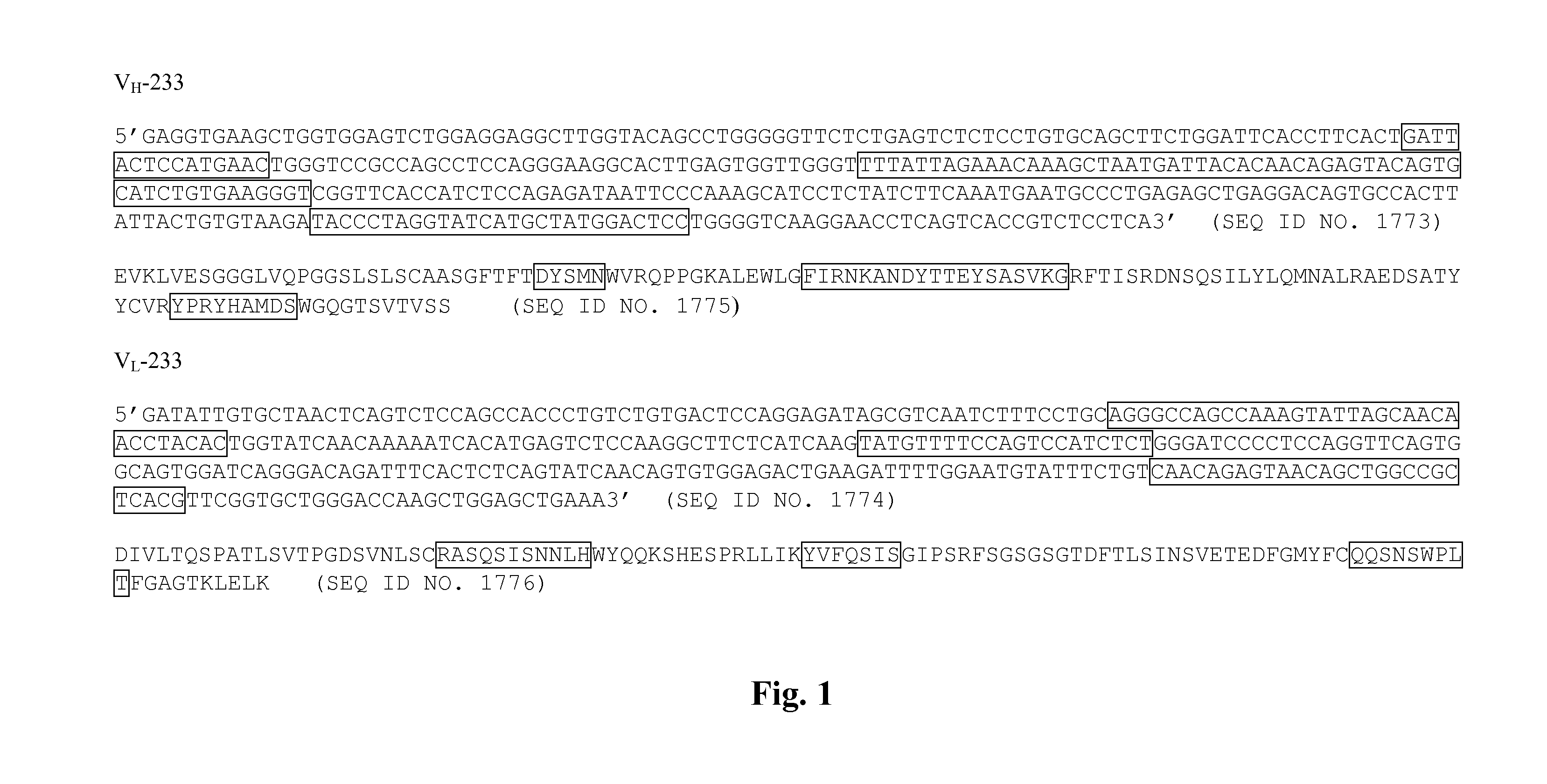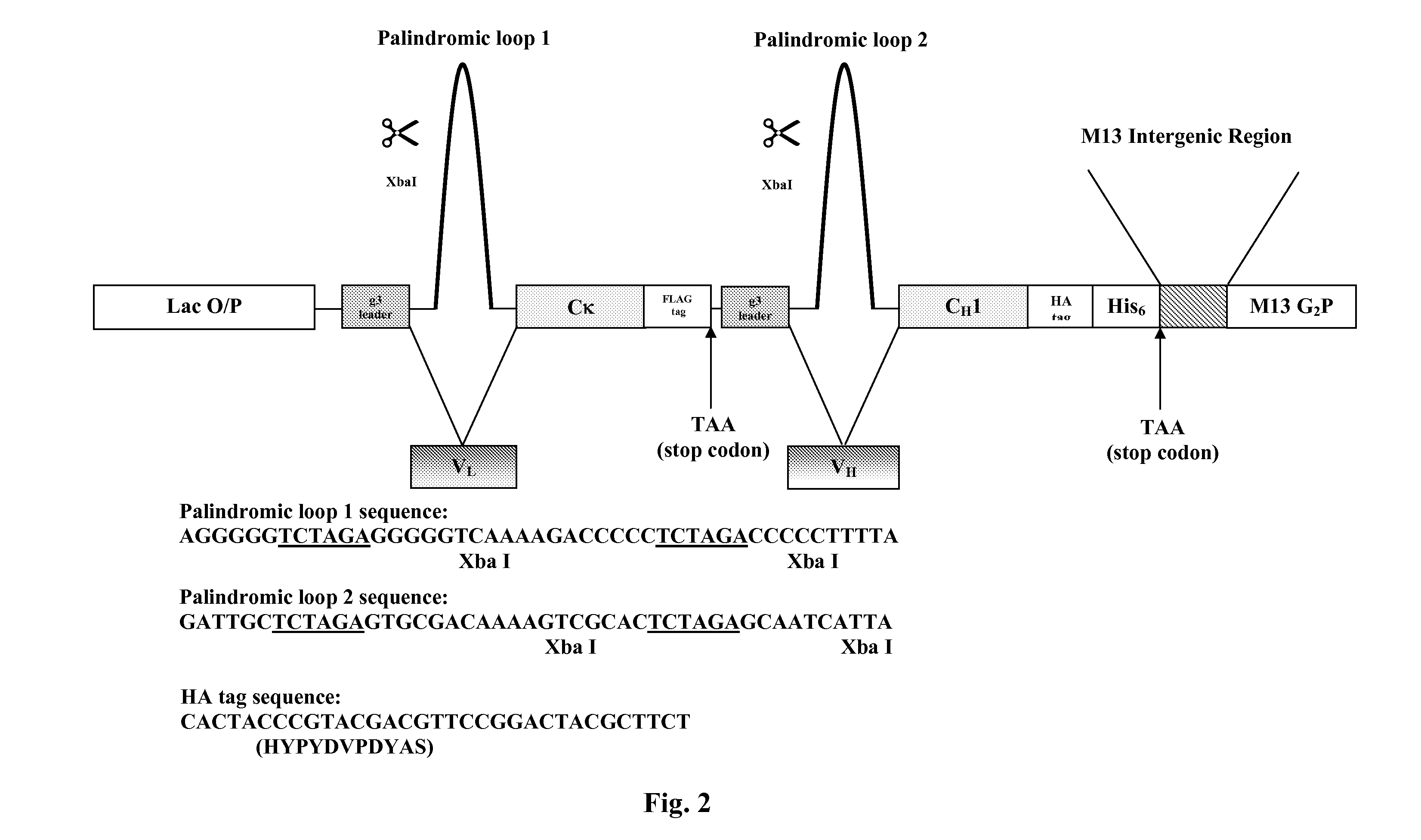Framework-Shuffling Of Antibodies
a framework and antibody technology, applied in the field of framework reshaping or reshaping antibodies, can solve the problems of undesirable immune response, limiting the possibility of selecting the best human template supporting the donor cdr, and affecting the use, especially in therapy
- Summary
- Abstract
- Description
- Claims
- Application Information
AI Technical Summary
Benefits of technology
Problems solved by technology
Method used
Image
Examples
example 1
8. EXAMPLE 1
Reagents
[0708]All chemicals were of analytical grade. Restriction enzymes and DNA-modifying enzymes were purchased from New England Biolabs, Inc. (Beverly, Mass.). pfu DNA polymerase and oligonucleotides were purchased from Invitrogen (Carlsbad, Calif.). Human EphA2-Fc fusion protein (consisting of human EphA2 fused with the Fc portion of a human IgG1 (Carles-Kinch et al. Cancer Res. 62: 2840-2847 (2002)) was expressed in human embryonic kidney (HEK) 293 cells and purified by protein G affinity chromatography using standard protocols. Streptavidin magnetic beads were purchased from Dynal (Lake Success, N.Y.). Human EphA2-Fc biotinylation was carried out using an EZ-Link Sulfo-NHS-LC-Biotinylation Kit according to the manufacturer's instructions (Pierce, Rockford, Ill.).
8.1 Cloning and Sequencing of the Parental Monoclonal Antibody
[0709]A murine hybridoma cell line (B233) secreting a monoclonal antibody (mAb) raised against the human receptor tyrosine kinase EphA2 (Kinch ...
example 2
9. EXAMPLE 2
Reagents
[0737]All chemicals were of analytical grade. Restriction enzymes and DNA-modifying enzymes were purchased from New England Biolabs, Inc. (Beverly, Mass.). SuperMix pfu DNA polymerase and oligonucleotides were purchased from Invitrogen (Carlsbad, Calif.). pfu ultra DNA polymerase was purchased from Stratagene (La Jolla, Calif.). Human EphA2-Fc fusion protein (consisting of human EphA2 fused with the Fc portion of a human IgG1; Carles-Kinch et al., Cancer Res. 62: 2840-2847 (2002)) was expressed in human embryonic kidney (HEK) 293 cells and purified by protein G affinity chromatography using standard protocols. Streptavidin magnetic beads were purchased from Dynal (Lake Success, N.Y.). Human EphA2-Fc biotinylation was carried out using an EZ-Link Sulfo-NHS-LC-Biotinylation Kit according to the manufacturer's instructions (Pierce, Rockford, Ill.).
9.1 Cloning and Sequencing of the Parental Monoclonal Antibody
[0738]A murine hybridoma cell line secreting a monoclonal ...
example 3
10. EXAMPLE 3
[0763]The thermal melting temperature (Tm) of the variable domain of antibodies is known to play a role in denaturation and aggregation. Generally a higher Tm correlates with better stability and less aggregation. As the process of framework-shuffling alters the variable region it was likely that the Tm of the framework-shuffled antibodies had been changed. The Tm of chimaeric B233 and the framework-shuffled antibodies were measured by differential scanning calorimetry (DSC) using a VP-DSC (MicroCal, LLC) using a scan rate of 1.0° C. / min and a temperature range of 25-110° C. A filter period of 8 seconds was used along with a 15 minute pre-scan thermostating. Samples were prepared by dialysis into 10 mM Histidine-HCl, pH 6 using Pierce dialysis cassettes (3.5 kD). Mab concentrations were 200-400 μg / mL as determined by A280. Melting temperatures were determined following manufacturer procedures using Origin software supplied with the system. Briefly, multiple baselines we...
PUM
| Property | Measurement | Unit |
|---|---|---|
| Tm | aaaaa | aaaaa |
| Tm | aaaaa | aaaaa |
| equilibrium dissociation constant | aaaaa | aaaaa |
Abstract
Description
Claims
Application Information
 Login to View More
Login to View More - R&D
- Intellectual Property
- Life Sciences
- Materials
- Tech Scout
- Unparalleled Data Quality
- Higher Quality Content
- 60% Fewer Hallucinations
Browse by: Latest US Patents, China's latest patents, Technical Efficacy Thesaurus, Application Domain, Technology Topic, Popular Technical Reports.
© 2025 PatSnap. All rights reserved.Legal|Privacy policy|Modern Slavery Act Transparency Statement|Sitemap|About US| Contact US: help@patsnap.com



